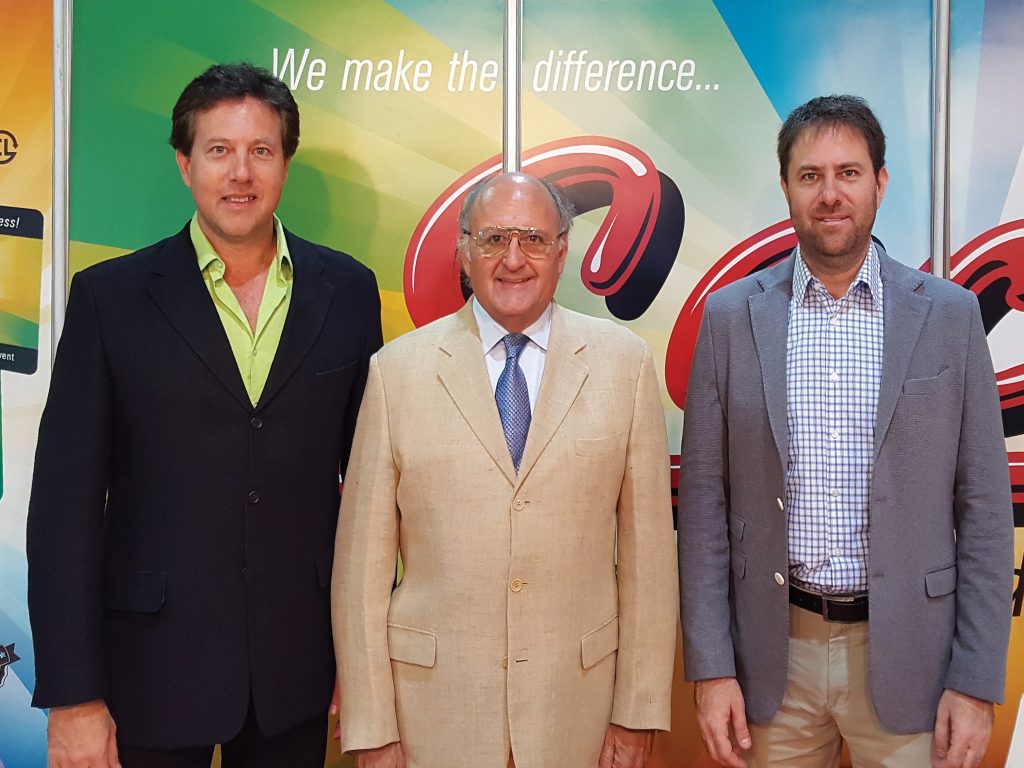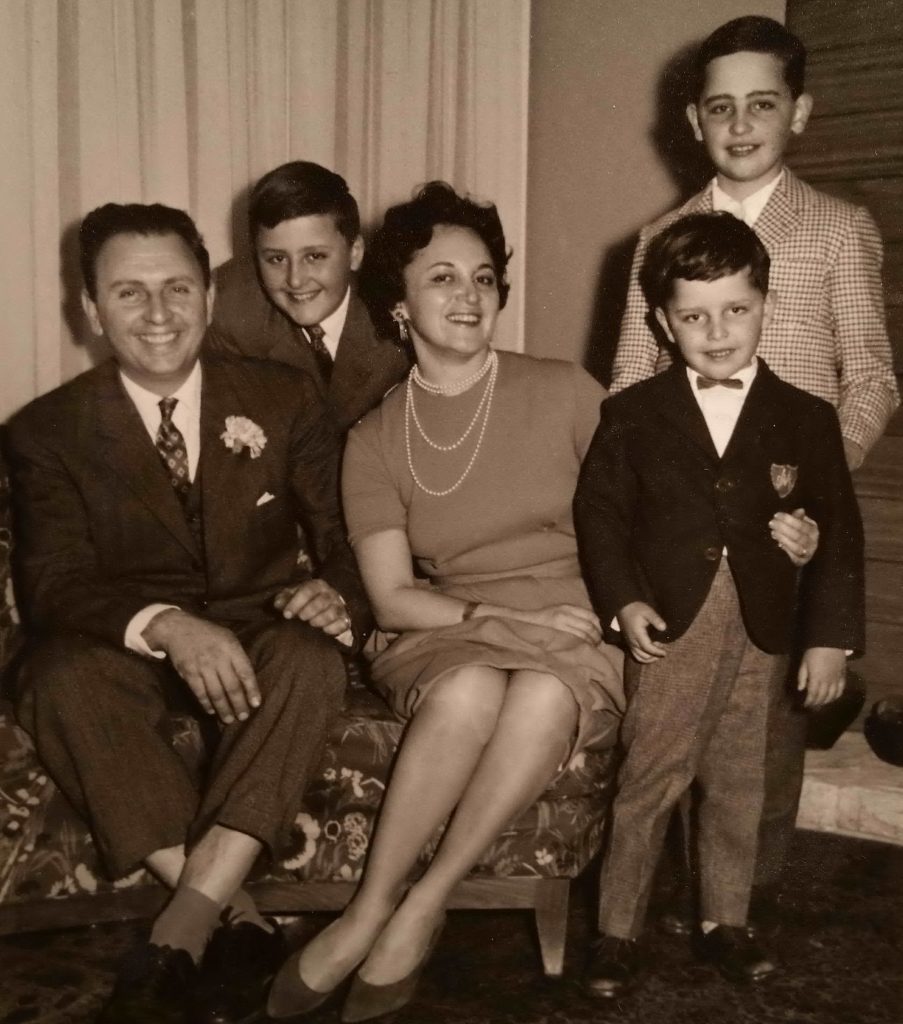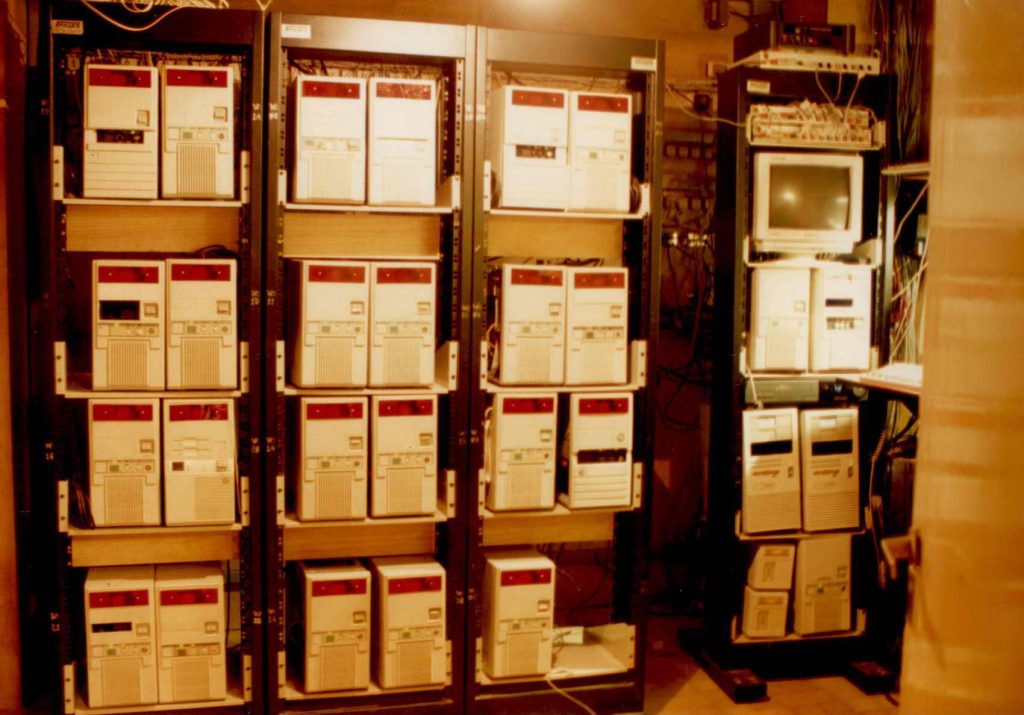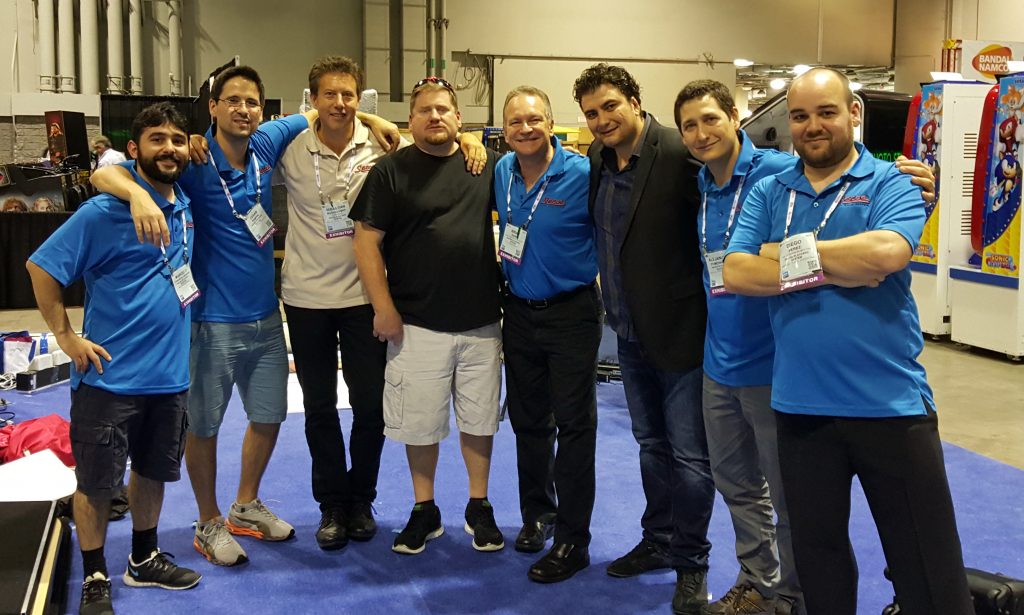
Jorge Mochkovsky (center) with sons Sebastian and Pol who run the company today.
From Argentina to the World
60-Year-Old Sacoa Got Its Start on the Street with Jukes & Pins;
FECs & Changing Technology Has Kept the Global Company Growing
As you read this month’s Cover Story, you might be reminded of what’s often described as the “American Dream,” how hard work, love of family, perseverance and ingenuity can lead to a successful, multi-generational business. In this case, think “Argentinian Dream” as we tell the storied history of the Mochkovsky family’s Sacoa, which is celebrating its 60th year in the amusement business, and also the 25th anniversary of the company’s flagship Playcard cashless system that’s installed in locations all around the world.
Before there was a “Sacoa,” family patriarch Mauricio Mochkovsky was a construction subcontractor in Mar del Plata, Argentina, and had a small firm, with just a few employees. His son and current company topper, Jorge Mochkovsky, recalls the times back then and how the whole family business started:

Mauricio and his family in the 1950s when they entered the amusement business (from left, Mauricio, Jorge, Beili, Ricardo and Alex).
“By 1957, the situation in the construction industry wasn’t good. One day while visiting a coffee shop, Dad made an interesting observation. While the jukebox was playing, two different guys chose a song by Domenico Modugno, which was extremely popular in those days. After the current tune ended, the Domenico Modugno song played, but just once. Mauricio later recalled having thought, ‘What a nice business this must be. Several people pay for a service, which is rendered only once, but everybody is happy because everyone thinks it is was played because of their choice.’”
Long story short, Mauricio got in touch with the owner of the jukebox and a few days later acquired his small route, consisting of three Wurlitzer jukes operating in coffee shops around the city. Two years later, he purchased 15 pinball machines that were stored in a basement. After a few days’ work, the first pinball, Exhibit’s 1938 Contact, was restored and placed on a revenue share basis in a bar located at a busy intersection.
“Traffic was very heavy and users openly played for money and the highest winner collected all. The cash box was very small and the one peso coins were large, so we had to collect the machine daily,” said Jorge.
Quickly after the pesos started plunking into the pinball, Mauricio realized restoring the rest of the pinballs would be a waste of time and instead decided to visit the U.S. to buy better equipment. During that trip, and several others he made in the early ’60s, Mauricio visited and made long-lasting relationships with many industry legends including Barney and Myron Sugerman, Al Simon, Len Schneller and Sam Weissman. (As for that initial, fresh machine shipment, it included about 30 pinballs, 20 bingos and a shuffle alley.)
Going forward, Mauricio and his son Jorge started a full-scale route, operating jukeboxes and Bally bingos in bars and sports clubs across the country, and were later joined by Alex and Ricardo, Mauricio’s other two sons. In 1969, they opened their first Sacoa Family Entertainment Center in Mar del Plata, which they proudly note was a huge success long before the term “FEC” was ever used in the U.S.
Building the Family Business
The Mochkovsky family and Sacoa have seen the industry through many years and more changes, and they recall how extremely profitable pins and jukeboxes were 50 years ago. The money came in from a different source with the advent of video games in the ’70s, and provided renewed profits and forms of entertainment for Sacoa to give their customers. However, various periods of import bans forced the company to begin to manufacture some of its own games, which ultimately gave them an edge over their local competitors.
“My wife Marta and I attended the MOA show in Chicago, 1976 or 1977, when Atari introduced Breakout,” he recalled. “We met Masaya Nakamura, and he and Marta ended up playing several games of Breakout. Communication was non-verbal, as Mr. Nakamura did not speak English, but from that moment on we forged a kind relationship that was renewed every time we met up at the shows in Japan and the U.S., many times chatting with the translation help of Hide Nakajima, the Namco vice president who later headed Atari Games.”
At the 1982 JAMMA show in Tokyo, Jorge remembers telling Nakamura that due to import restrictions in Argentina, Sacoa wouldn’t be able to import complete Pole Position games from Namco, and that their profitable summer season was about to begin. Not wanting to be left behind, Jorge devised a plan: They’d build their own. “Mr. Nakamura agreed to supply two sets of PC boards taken out of the show floor games, that we happily hand-carried back home,” said Jorge, building the games themselves. “Our flagship location had Pole Position a year earlier than any competitor!” (Sacoa went on to build their own games numerous times in those years.)
As the video game boom continued, leading manufacturers from all over the world such as Atari, Namco, Sega, Williams and others made distribution agreements with the Argentinian company, helping the Sacoa brand take off.
Shifting Focus
Over time, home video games and other forms of inexpensive entertainment had a strong, negative impact on the company and industry in general. In order to adapt, Sacoa shifted away from street arcades to FECs in malls and movie theater complexes with redemption, group games and midway games –– a move to attractions that could not be found at home.
All the while, Sacoa maintained its family-run focus. Sebastian, Jorge’s son and current director of operations at Sacoa, recalls his early start in “FEC management:” “At about 10 years old, I remember taking bags of 100 tokens from the administration, supposedly to play, but then I would actually sit at an empty cashier to sell my own tokens to customers, keeping the cash of course! To avoid being robbed, I would have employees stay by my side as bodyguards. One of those employees, is the current general manager of operations of the company today!”
Today, Sacoa is a household name in Argentina with Jorge at the helm and sons Sebastian and Pol now making their own mark in the firm’s evolution. The company operates over 20 FECs in shopping malls, cinema complexes and high-traffic, seaside resorts. The facilities are strong on redemption and offer many indoor rides, including bumper cars, a Ferris Wheel, virtual reality simulators, small roller coasters, and so on. The average size of their locations is 12,000 square feet, with the largest FEC measuring 40,000 square feet and featuring a dozen rides.
Sacoa also operates a 200,000-square-foot outdoor amusement park in Quito, Ecuador, named Vulqano Park, which has 30 rides, a central midway building with food court, an arcade and a special events room.
“This was a great experience for us. We designed the concept, selected the rides and games, and set up the whole amusement park with the valuable knowledge of our engineers, technicians and managers,” said Pol Mochkovsky, CEO of the project. “This experience set the milestone for Sacoa’s consulting services in operations, now offered worldwide.”

A scene from the company’s early computer room in 1993 when they had first replaced tokens with a computerized magnetic card system. One computer took care of the operations of 25 games back then and the location had 400 games at the time! There were lots of PCs, plus servers and back office computers, explained Sebastion, adding: “Today, you can run the same quantity of games with a single unit if you want.”
A New Path: The Playcard System
In the late ’80s and early ’90s, coinciding with the expansion in Argentina’s economy, the family business began growing to nationwide proportions, reaching up to 50 locations. Jorge then realized they needed a much better way to control operations, keep track of the revenue, rotate games wisely, modify prices to compensate for inflation and avoid theft. So the Sacoa Playcard system was developed in-house to optimize the company’s own operation. By 1993, the first Sacoa Entertainment store replaced traditional tokens with a computerized magnetic debit card system, starting the company’s foray into cashless systems.
“The date we made history was March 1993 when we installed the Playcard system in one of our centers to evaluate customers’ reactions and to make sure it was working properly. It worked better than we dared dream and the best part was that collections went up 30 percent!” Sebastian said. “We saw that and asked ourselves what kind of magic was going on. It turned out that no magic was involved, just the use of the correct tool to run the business at peak efficiency.”
Sebastian says everyone at the company was so excited and anxious to install the system as soon as possible at all Sacoa centers that they completed the job in less than a year. Like the first installation, revenues rose at each venue that got the new system. On top of that, the company had another surprise: locations where there was heavy competition saw larger revenue increases.
“I’m talking about an area of about six or seven blocks with eight or nine amusement centers. Again, it seemed like magic when our slice of the cake grew,” Sebastian emphasized.
The system’s hardware and software were developed and manufactured by a sister company called Sacoa Playcard System, which initially supplied all Sacoa FECs. After the success at its own locations, Sacoa sold the system in 1994 to its first external customer, an operation in Brazil, and soon started exporting to other countries.
In 1995, Dave & Buster’s, then an eight-store chain, bought the card system for one location, planning to test it for six months. After three weeks, Sebastian said, they wanted to have the system installed in the other Dave & Buster’s and Sacoa did so over the next three months.
Being experienced operators –– and having their own locations where they could test new system features and see immediate results –– helped Sacoa forge a sense of trust and comfort in other operators thinking about using the Playcard System.
As Sebastian explained, “We had high-quality product backed by a prestigious company with an exemplary track record. We showed prospective customers real-life cases that demonstrated how quickly they could recover their initial investment and also pointed out some of the operational possibilities open to them with a system like ours, completely impossible to achieve without one.”
According to Sebastian, this quickly led the Playcard System to great growth, with over 1,500 installations in more than 60 countries today.
The Evolution of the Playcard System
Although the Playcard System started simply managing games at a location and selling/recharging the cards, it quickly evolved into an integrated solution that can be used universally throughout many locations. The system today can manage multiple aspects of a business, from redemption and food/beverage inventories, to online sales and party bookings, membership and loyalty programs as well as integration with several specialized point of sales and bowling vendors.
As Pol recalls, “The first version of the Playcard system allowed us basic features as individual game price setting, automated digital revenue reports and cashier sales control, which was our initial goal. But shortly after, we realized the power of the ‘marketing system’ and were the first to create new features, which are mostly standard in the card system industry today, such as the VIP status, automated price tables, instant lottery on POS recharges, time cards and more.”
Pol also says one feature the company created in 1994 didn’t succeed until a few years ago: the implementation of the electronic tickets for redemption games. At the time, Pol says the market and the player were not ready for the development, but now it is a growing trend.
As the market turned more and more demanding, and new requirements surfaced from operators all over the world, the company strove to develop and introduce new features every year. Those features kept coming, such as the self-service kiosks that allow customers to purchase, recharge and analyze cards on their own; the roaming feature, which allowed customers to roam their card balance from one company’s location to another; or the multi-attendant and multi-session redemption counter software used through barcode scanners to provide speedy customer service.
“We were pioneers, and continue to be, in gaming-related solutions,” Pol said.
As he highlights, the implementation of a wireless game network operated through Access Points distributed throughout the store, which eliminated the hassle of running wiring to or from the games or turnstiles and allowed changing the game layout as easily as moving furniture around, was also a revolutionary step.
Always Evolving

George and Marta help set up during an IAAPA show; below, the Sacoa team from all over the world at IAAPA.
When asked about the present, Sebastian points out that the Internet, tablets and smart phones have had a great impact on the market offering direct payment solutions. People are much more used to, and now sometimes prefer, conducting their business over the Internet, whether that is online party booking or recharging Playcards with their mobile phone.
Sebastian also notes an interesting trend towards RFID “Tap to Credit” Technology, due to the reduction of the production cost, which allows for the option of “contactless” payment. Sacoa’s best-seller, the Color-Shot HDT RF reader, is a multi-function card reader that serves that trend, offering mag stripe and RFID payment options in one reader.
“Also, among the latest innovations,” he explained, “we have two applications that can be run on regular Android tablets, the mReader, a full, user-friendly mobile version of the Sacoa Access Controller capable of accepting any type of credit from MAG/RFID cards and wristbands to allow access for attractions, and the mPOS, a mobile version of the Sacoa POS with NFC capability, that can sell food and beverage or retail merchandise as well as Playcards, accepting cash, credit cards or Playcard credit as payment.”

Sebastian also highlighted the company’s new mPOS software, which operates on a tablet and serves as a mobile point of sale, allowing location owners to better tackle long lines and busy times with roaming attendants. He also praised Sacoa’s mReader, which he says has high demand in amusement parks.
From the jukebox-inspired dreams of Mauricio to the continued vision of Jorge, the Mochkovsky’s and Sacoa have evolved into a third-generation family business with 650 employees and offices worldwide. All along the way, the same future-oriented spirit remains, always looking to explore the new possibilities available with the latest technologies introduced.
“We created a path followed by our competitors and intend to continue in that direction, at the vanguard while delivering quality products backed by a can-do ethic and legacy of exemplary service after the sale,” Sebastian concluded.
For more information, visit Sacoa at www.sacoa.com and www.sacoacard.com.
